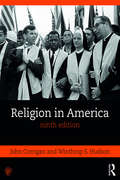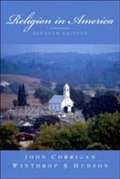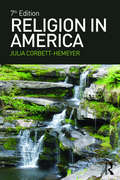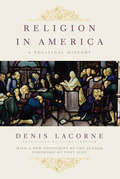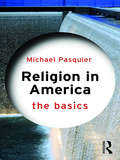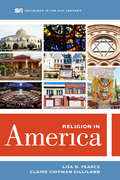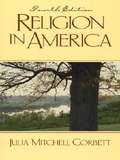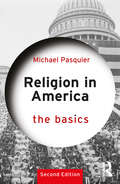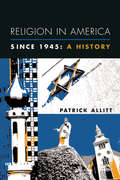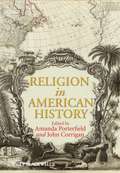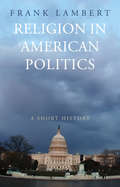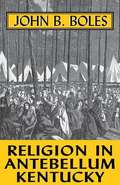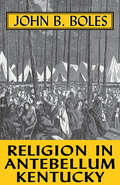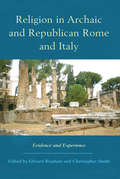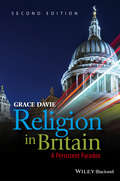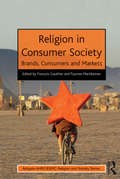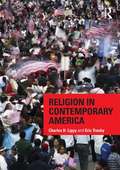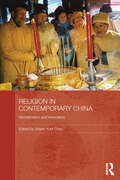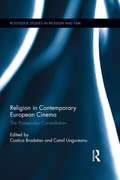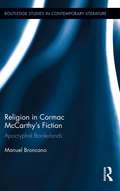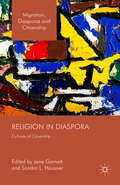- Table View
- List View
Religion in America: Concepts Of American Identity And Mission
by John Corrigan Winthrop HudsonThis comprehensive narrative account of religion in America from the sixteenth century through the present depicts the religious life of the American people within the context of American society. It addresses topics ranging from the European origins of American religious thought and the diversity of religion in America, to the relation of nationhood with religious practice and the importance of race, ethnicity, and gender in American religious history. Split into four parts this textbook covers: Religion in a Colonial Context, 1492-1789 The New Nation, 1789-1865 Years of Midpassage, 1865-1918 Modern America, 1918- Present This new edition has been thoroughly updated to include further discussion of colonialism, religious minorities, space and empire, religious freedom, emotion, popular religion, sexuality, the ascent of the "nones," Islamophobia, and the development of an American mission to the world. With a detailed timeline, illustrations and maps throughout, and an accompanying companion website Religion in America is the perfect introduction for students new to the study of this topic who wish to understand the key themes, places, and people who shaped the world as we know it today.
Religion in America: An Historical Account of the Development of American Religious Life (7th edition)
by John Corrigan Winthrop S. HudsonThe history of religion in the United States.
Religion in America
by Julia Corbett HemeyerReligion in America, 7th Edition provides a comprehensive yet concise introduction to the changing religious landscape of the United States. Extensively revised and updated to reflect current events and trends, this new edition continues to engage students in reflection about religious diversity. Julia Corbett-Hemeyer presents the study of religion as a tool for developing appreciation of communities of faith other than one’s own and for understanding the dynamics at work in religion in the United States today.?
Religion in America
by Tony Judt George Holoch Denis LacorneAmerica is unique in that its political institutions preceded the development of a national identity. The American Revolution and drafting of the constitution did not deepen a preexisting national self. Rather, it created a new political framework to which the "walls" of culture, particularly references to a distant past, were later added. Revisiting this moment in American history and the nation's early efforts at identity, Denis Lacorne identifies two competing narratives drawn from a reformulation of America's past, present, and future.The first narrative, derived from the philosophy of the Enlightenment, is essentially secular. Associated with the Founding Fathers and reflected in the Declaration of Independence, the Constitution, and the Federalist Papers, it is predicated on separating religion from politics to preserve political freedom from an overpowering church. Prominent thinkers such as Voltaire, Thomas Paine, and Jean-Nicolas Démeunier, who viewed the American project as a radical attempt to create a new regime free from religion and the weight of ancient history, embraced the American effort to establish a genuine "wall of separation" between church and state. The second narrative casts national identity as the outcome of a progression toward freedom, beginning with the Reformation and culminating with the colonies of Puritan New England. This alternative vision was adopted by Whig politicians and romantic historians, yet still persists among political scientists such as Samuel Huntington. These thinkers insist that America has a core, stable "American creed" based on a mix of Protestant and republican values. Lacorne outlines the role of religion in the making of these narratives and examines, against this background, how key historians, philosophers, novelists, and intellectuals situate religion in American politics.
Religion in America: A Political History (Religion, Culture, and Public Life #7)
by Denis LacorneDenis Lacorne identifies two competing narratives defining the American identity. The first narrative, derived from the philosophy of the Enlightenment, is essentially secular. Associated with the Founding Fathers and reflected in the Declaration of Independence, the Constitution, and the Federalist Papers, this line of reasoning is predicated on separating religion from politics to preserve political freedom from an overpowering church. Prominent thinkers such as Voltaire, Thomas Paine, and Jean-Nicolas Démeunier, who viewed the American project as a radical attempt to create a new regime free from religion and the weight of ancient history, embraced this American effort to establish a genuine "wall of separation" between church and state. The second narrative is based on the premise that religion is a fundamental part of the American identity and emphasizes the importance of the original settlement of America by New England Puritans. This alternative vision was elaborated by Whig politicians and Romantic historians in the first half of the nineteenth century. It is still shared by modern political scientists such as Samuel Huntington. These thinkers insist America possesses a core, stable "Creed" mixing Protestant and republican values. Lacorne outlines the role of religion in the making of these narratives and examines, against this backdrop, how key historians, philosophers, novelists, and intellectuals situate religion in American politics.
Religion in America
by Denis Lacorne George Holoch Tony JudtAmerica is unique in that its political institutions preceded the development of a national identity. The American Revolution and drafting of the constitution did not deepen a preexisting national self. Rather, it created a new political framework to which the "walls" of culture, particularly references to a distant past, were later added. Revisiting this moment in American history and the nation's early efforts at identity, Denis Lacorne identifies two competing narratives drawn from a reformulation of America's past, present, and future.The first narrative, derived from the philosophy of the Enlightenment, is essentially secular. Associated with the Founding Fathers and reflected in the Declaration of Independence, the Constitution, and the Federalist Papers, it is predicated on separating religion from politics to preserve political freedom from an overpowering church. Prominent thinkers such as Voltaire, Thomas Paine, and Jean-Nicolas Démeunier, who viewed the American project as a radical attempt to create a new regime free from religion and the weight of ancient history, embraced the American effort to establish a genuine "wall of separation" between church and state. The second narrative casts national identity as the outcome of a progression toward freedom, beginning with the Reformation and culminating with the colonies of Puritan New England. This alternative vision was adopted by Whig politicians and romantic historians, yet still persists among political scientists such as Samuel Huntington. These thinkers insist that America has a core, stable "American creed" based on a mix of Protestant and republican values. Lacorne outlines the role of religion in the making of these narratives and examines, against this background, how key historians, philosophers, novelists, and intellectuals situate religion in American politics.
Religion in America: French Missionaries And The Roman Catholic Priesthood In The United States, 1789-1870 (The Basics)
by Michael PasquierReligion in America: The Basics is a concise introduction to the historical development of religions in the United States. It is an invitation to explore the complex tapestry of religious beliefs and practices that shaped life in North America from the colonial encounters of the fifteenth century to the culture wars of the twenty-first century. Far from a people unified around a common understanding of Christianity, Religion in America: The Basics tracks the steady diversification of the American religious landscape and the many religious conflicts that changed American society. At the same time, it explores how Americans from a variety of religious backgrounds worked together to face the challenges of racism, poverty, war, and other social concerns. Because no single survey can ever satisfy the need to know more and think differently, Religion in America prepares readers to continue studying American religions with their own questions and perspectives in mind.
Religion in America (Sociology in the Twenty-First Century #6)
by Lisa D. Pearce Claire Chipman GillilandWritten in an engaging and accessible tone, Religion in America probes the dynamics of recent American religious beliefs and behaviors. Charting trends over time using demographic data, this book examines how patterns of religious affiliation, service attendance, and prayer vary by race and ethnicity, social class, and gender. The authors identify demographic processes such as birth, death, and migration, as well as changes in education, employment, and families, as central to why some individuals and congregations experience change in religious practices and beliefs while others hold steady. Religion in America challenges students to examine the demographic data alongside everyday accounts of how religion is experienced differently across social groups to better understand the role that religion plays in the lives of Americans today and how that is changing.
Religion in America (4th edition)
by Julia Mitchell CorbettThis text might be used in a course titled "religion appreciation." Corbett (religious studies, Ball State U.) offers an introduction to a variety of religious groups in the United States and stresses the diversity of the American religious scene in order to accentuate understanding of other communities of faith. Each chapter offers suggestions for further reading and relevant Web sites, as well as questions and activities to aid teachers in discussions and writing assignments.
Religion in America: The Basics (The Basics)
by Michael PasquierReligion in America: The Basics is a concise introduction to the historical development of religions in the United States. It is an invitation to explore the complex tapestry of religious beliefs and practices that shaped life in North America from the colonial encounters of the fifteenth century to the culture wars of the twenty-first century. Far from a people unified around a common understanding of Christianity, Religion in America: The Basics tracks the steady diversification of the American religious landscape and the many religious conflicts that have changed American society. At the same time, it explores how Americans from a variety of religious backgrounds worked together to face the challenges of racism, poverty, war, and other social concerns. This thoroughly revised second edition now covers the Obama and Trump administrations, Black Lives Matter, Christian nationalism, pluralism, and the development of the "nones" and the "unaffiliated." With each chapter featuring concise summaries and suggested further readings, this book is an invaluable resource for students approaching the history of religion in America for the first time.
Religion in America Since 1945: A History (Columbia Histories of Modern American Life)
by Patrick AllittMoving far beyond the realm of traditional "church history," Patrick Allitt here offers a vigorous and erudite survey of the broad canvas of American religion since World War II. Identifying the major trends and telling moments within major denominations and also in less formal religious movements, he asks how these religious groups have shaped, and been shaped by, some of the most important and divisive issues and events of the last half century: the Cold War, the Civil Rights Movement, the Vietnam War, feminism and the sexual revolution, abortion rights, the antinuclear and environmentalist movements, and many others. Allitt argues that the boundaries between religious and political discourse have become increasingly blurred in the last fifty years. Having been divided along denominational lines in the early postwar period, religious Americans had come by the 1980s to be divided along political lines instead, as they grappled with the challenges of modernity and secularism. Partly because of this politicization, and partly because of the growing influence of Asian, Latino, and other ethnic groups, the United States is anomalous among the Western industrialized nations, as church membership and religious affiliation generally increased during this period. Religion in America Since 1945 is a masterful analysis of this dynamism and diversity and an ideal starting point for any exploration of the contemporary religious scene.
Religion In America (Sixth Edition)
by Julia Corbett HemeyerReligion in America gives students and teachers a comprehensive yet concise introduction to the changing religious landscape of the United States. Extensively revised and updated, the Sixth Edition continues to engage students in reflection about religious diversity. The author presents the study of religion within the context of the humanities as a tool for developing understanding and appreciation of communities of faith other than ones own, and for understanding the dynamics at work in religion in the United States today.
Religion In American History
by Amanda Porterfield John CorriganThis student-friendly introduction combines both thematic and chronological approaches in exploring the pivotal role religion played in American history - and of its impact across a range of issues, from identity formation and politics, to race, gender, and class. <p><p> A comprehensive introduction to American religious history that successfully combines thematic and chronological approaches, aiding both teaching and learning <p> Brings together a stellar cast of experts to trace the development of theology, the political order, practice, and race, ethnicity, gender and class throughout America's history <p> Accessibly structured in to four key eras: Exploration and Encounter (1492-1676); The Atlantic World (1676-1802); American Empire (1803-1898); and Global Reach (1898-present). <p> Investigates the role of religion in forming people's identities, emotional experiences, social conflict, politics, and patriotism
Religion in American Politics: A Short History
by Frank LambertThe delegates to the 1787 Constitutional Convention blocked the establishment of Christianity as a national religion. But they could not keep religion out of American politics. From the election of 1800, when Federalist clergymen charged that deist Thomas Jefferson was unfit to lead a "Christian nation," to today, when some Democrats want to embrace the so-called Religious Left in order to compete with the Republicans and the Religious Right, religion has always been part of American politics. In Religion in American Politics, Frank Lambert tells the fascinating story of the uneasy relations between religion and politics from the founding to the twenty-first century. Lambert examines how antebellum Protestant unity was challenged by sectionalism as both North and South invoked religious justification; how Andrew Carnegie's "Gospel of Wealth" competed with the anticapitalist "Social Gospel" during postwar industrialization; how the civil rights movement was perhaps the most effective religious intervention in politics in American history; and how the alliance between the Republican Party and the Religious Right has, in many ways, realized the founders' fears of religious-political electoral coalitions. In these and other cases, Lambert shows that religion became sectarian and partisan whenever it entered the political fray, and that religious agendas have always mixed with nonreligious ones. Religion in American Politics brings rare historical perspective and insight to a subject that was just as important--and controversial--in 1776 as it is today.
Religion in an Age of Science
by Ian G. BarbourReligion and Science is a comprehensive examination of the major issues between science and religion in today's world. With the addition of three new historical chapters to the nine chapters (freshly revised and updated) of Religion in an Age of Science, winner of the Academy of Religion Award for Excellence in 1991, Religion and Science is the most authoritative and readable book on the subject, sure to be used by science and religion courses and discussion groups and to become the introduction of choice for general readers.
Religion In Antebellum Kentucky
by John B. Boles"An excellent survey of religion and its significance in the first eighty-five years of Kentucky's history. John B. Boles is professor of History at Rice University and managing editor of the Journal of Southern History. He is the author and editor of several books, including Masters and Slaves in the House of the Lord, Black Southerners, and The Great Revival. He edits the series ""Religion in the South"" for the University Press of Kentucky.
Religion in Antebellum Kentucky
by John B. BolesA look at the Christian religions in the Bluegrass State before the Civil War from the author of the acclaimed Jefferson: Architect of American Liberty.Religion permeated the day-to-day life of antebellum Kentucky. This engaging account of Kentucky’s various Christian denominations, first published as part of the Kentucky Bicentennial Bookshelf, traces the history of the Great Revival of 1800–1805, the subsequent schism in Protestant ranks, the rise of Catholicism, the development of a distinctive black Christianity, and the growth of a Christian antislavery tradition.Paying special attention to the role of religion in the everyday life of early Kentuckians and their heritage, John B. Boles provides a concise yet enlightening introduction to the faith and the people of the Bluegrass State. Religion in Antebellum Kentucky is an excellent survey of religion and its significance in the first eighty-five years of Kentucky’s history.“A small historical gem . . . Boles has set an admirable standard of excellence for this sort of study.” —William and Mary Quarterly
Religion in Archaic and Republican Rome and Italy: Evidence and Experience
by Christopher Smith Edward BisphamFirst Published in 2001. Routledge is an imprint of Taylor & Francis, an informa company.
Religion in Britain: A Persistent Paradox
by Grace DavieReligion in Britain evaluates and sheds light on the religious situation in twenty-first century Britain; it explores the country’s increasing secularity alongside religion’s growing presence in public debate, and the impact of this paradox on Britain’s society. Describes and explains the religious situation in twenty-first century Britain Based on the highly successful Religion in Britain Since 1945 (Blackwell, 1994) but extensively revised with the majority of the text re-written to reflect the current situation Investigates the paradox of why Britain has become increasingly secular and how religion is increasingly present in public debate compared with 20 years ago Explores the impact this paradox has on churches, faith communities, the law, politics, education, and welfare
Religion in Consumer Society: Brands, Consumers and Markets (AHRC/ESRC Religion and Society Series)
by François GauthierPresenting an overview of an emerging field in the study of contemporary religion, this book, together with a complementary volume Religion in the Neoliberal Age, explores issues of religion, neoliberalism and consumer society. Claiming that we have entered a new phase that implies more than the recasting of state-religion relations, the authors examine how religious changes are historically anchored in modernity but affected by the commoditization, mediatization, neoliberalization and globalization of society and social life. Religion in Consumer Society explores religion as both shaped by consumer culture and as shaping consumer culture. Following an introduction which critically analyses studies on consumer culture and integrates scholarship in the sociology of religion, this book explores the following topics: how consumerism and electronic media have shaped globalized culture, and how this is affecting religion; the dynamics and characteristics of often overlooked middle-class religion, and how these relate to globalization and differences between 'developed' and 'emerging' countries; emerging trends, and how we understand phenomena as different as mega churches and holistic spiritualistic journeys, and how the pressures of consumer culture act on religious traditions, indigenous and exogenous; the politics of religious phenomena in the Age of Neoliberalism; and the hybrid areas emerging from these reconfigurations of religion and the market. Outlining changes in both the political-institutional and cultural spheres, the contributors offer an international overview of developments in different countries and state of the art representation of religion in the new global political economy.
Religion in Contemporary America
by Charles H. Lippy Eric TranbyThis book provides a fresh, engaging multi-disciplinary introduction to religion in contemporary America. The chapters explore the roots of contemporary American religion from the 1950s up to the present day, looking at the major traditions including mainline Protestantism, the evangelical-pentecostal surge, Catholicism, Judaism, African-American religions and new religious movements. The authors ask whether Americans are becoming less religious, and how religious thought has moved from traditional systematic theology to approaches such as black and feminist theology and environmental theology. The book introduces religion and social theory, and explores key issues and themes such as: religion and social change; politics; gender; sexuality; diversity; race and poverty. Students and instructors will find the combination of historical and sociological perspectives an invaluable aid to understanding this fascinating but complex field.
Religion in Contemporary China: Revitalization and Innovation (Routledge Contemporary China Series)
by Adam Yuet ChauBefore the modernist transformations of the twentieth century, China had one of the richest and most diverse religious cultures in the world. The radical anti-traditionalist policies of both the Republican and Communist regimes as well as other socio-historical factors posed formidable challenges to China’s religious traditions but, this book argues, these conditions also presented new opportunities for re-generation and innovation. It shows that economic reforms and the concurrent relaxation of religious policies have provided fertile ground for the revitalization of a wide array of religious practices, including divination, ancestor worship, temple festivals, spirit mediumism, churchgoing, funeral rites, exorcism, pilgrimages, sectarianism, sutra chanting, and the printing and distribution of morality books. Equally new forms of religious practices have emerged such as lay Buddhist preachers, "Maoist shamans", and a range of qigong sects/schools. Written by an international, interdisciplinary team of experts who have all conducted in-depth fieldwork research in China, this book provides a wide-ranging survey of contemporary religious practices in China. It examines the different processes and mechanisms of religious revivals and innovations, and, more broadly, relates the Chinese example of religious revitalization to larger issues of social and cultural continuity and change.
Religion in Contemporary European Cinema: The Postsecular Constellation (Routledge Studies in Religion and Film)
by Camil Ungureanu Costica BradatanThe religious landscape in Europe is changing dramatically. While the authority of institutional religion has weakened, a growing number of people now desire individualized religious and spiritual experiences, finding the self-complacency of secularism unfulfilling. The "crisis of religion" is itself a form of religious life. A sense of complex, subterraneous interaction between religious, heterodox, secular and atheistic experiences has thus emerged, which makes the phenomenon all the more fascinating to study, and this is what Religion in Contemporary European Cinema does. The book explores the mutual influences, structural analogies, shared dilemmas, as well as the historical roots of such a "post-secular constellation" as seen through the lens of European cinema. Bringing together scholars from film theory and political science, ethics and philosophy of religion, philosophy of film and theology, this volume casts new light on the relationship between the religious and secular experience after the death of the death of God.
Religion in Cormac McCarthy's Fiction: Apocryphal Borderlands (Routledge Studies in Contemporary Literature)
by Manuel BroncanoThis book addresses the religious scope of Cormac McCarthy’s fiction, one of the most controversial issues in studies of his work. Current criticism is divided between those who find a theological dimension in his works, and those who reject such an approach on the grounds that the nihilist discourse characteristic of his narrative is incompatible with any religious message. McCarthy’s tendencies toward religious themes have become increasingly more acute, revealing that McCarthy has adopted the biblical language and rhetoric to compose an "apocryphal" narrative of the American Southwest while exploring the human innate tendency to evil in the line of Herman Melville and William Faulkner, both literary progenitors of the writer. Broncano argues that this apocryphal narrative is written against the background of the Bible, a peculiar Pentateuch in which Blood Meridian functions as the Book of Genesis, the Border Trilogy functions as the Gospels, and No Country for Old Men as the Book of Revelation, while The Road is the post-apocalyptic sequel. This book analyzes the novels included in what Broncano defines as the South-Western cycle (from Blood Meridian to The Road) in search of the religious foundations that support the narrative architecture of the texts.
Religion in Diaspora: Cultures of Citizenship (Migration, Diasporas and Citizenship)
by Jane Garnett Sondra L. HausnerThis edited collection addresses the relationship between diaspora, religion and the politics of identity in the modern world. It illuminates religious understandings of citizenship, association and civil society, and situates them historically within diverse cultures of memory and state traditions.
